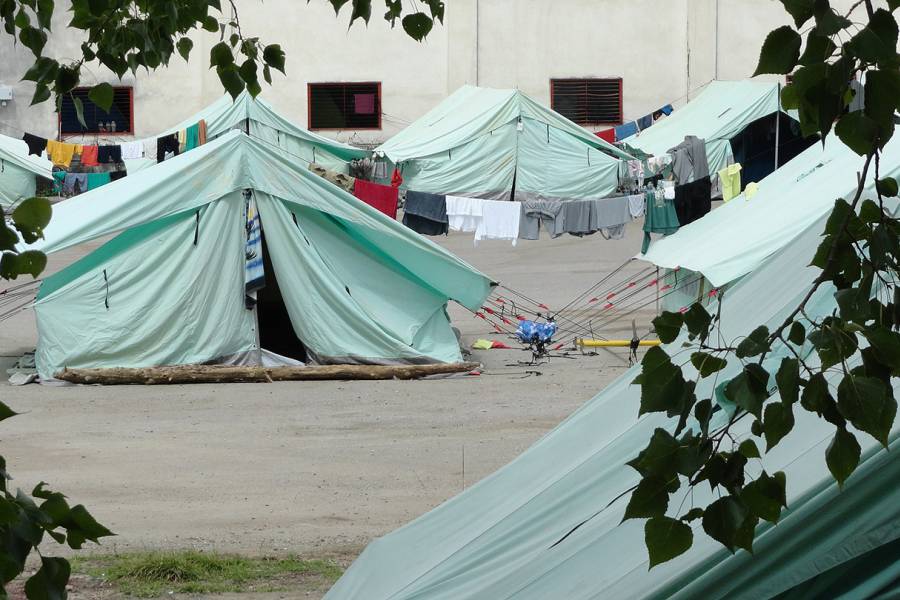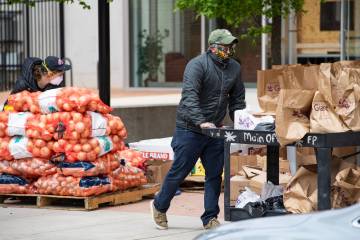As the COVID-19 pandemic spreads around the globe, human rights organizations are warning of the disproportionate impact the coronavirus will have on the world's most vulnerable populations—including refugees.
Paul Spiegel is the director of the Johns Hopkins Center for Humanitarian Health and former deputy director for the United Nations High Commissioner for Refugees. His research focuses on preventing and responding to complex humanitarian emergencies. He joined Johns Hopkins MPH/MBA candidate Samuel Volkin for a discussion on how refugee populations may be affected by the COVID-19 pandemic. This conversation has been edited for length and clarity.
How does a person become a refugee?
Asylum seekers are people who have fled persecution due to fear for their safety and have crossed an internationally recognized border into another country. After formally applying for asylum and being granted refugee status, a person becomes a refugee. There are approximately 25 million refugees worldwide. The largest number of refugees are from Syria, Afghanistan, Somalia, South Sudan, and Burma/Myanmar.
What puts refugees at a high risk of being affected by COVID-19?
It varies by refugee population and what the status of the pandemic is where they are living. Refugees will be infected and affected in a similar way to their host communities. Yet refugees are more vulnerable.
Refugee camps—in which about one out of every three refugees lives—are often located in remote areas with limited health care. Usually, there aren't any hospitals in refugee camps. Some of the bigger camps do have them, but few of them will have ICUs or ventilators. There's a pressing question of whether refugees will be able to access host-country hospitals and ICUs when, in many cases, there aren't enough for that country's national population. So access to health care is a major vulnerability.
Second, refugees often live with multiple families in very high population-density conditions. It's going to be extremely difficult for them to social distance—because there really isn't anywhere to social distance. People are especially concerned about the Rohingya population in Bangladesh because they are almost 900,000 people in an incredibly dense area.
Refugees are also more likely to have underlying health conditions such as acute malnutrition. Because of this, there is a lot of concern that the COVID-19 infection will affect refugees more severely than people in their host communities.
There are also over 40 million people who have left their home in fear of persecution and conflict but remain in their country. Internally displaced persons such as those in Darfur, Sudan, as well as Idlib, Syria, are at extreme risk because they are being persecuted in their own country and don't have the same rights that refugees have. The health care system in these places is in shambles, and if COVID-19 affects those populations, they're going to be in a lot of trouble.
Have there already been COVID-19 outbreaks within refugee populations?
They're starting. There's an outbreak in the Greek detention centers for asylum seekers and migrants. In a closed, detentionlike setting, the pandemic will spread like wildfire. That's one of the worst scenarios. It is not a good idea to put people in those sorts of conditions. There have also been cases of COVID-19 among asylum seekers and migrants in U.S. detention centers.
There have been small outbreaks in several other countries as well. But as of now, the worst is yet to come as the pandemic expands to the Middle East, Africa, and other parts of Asia because that's where most refugees are located.
Are any measures being taken to make social distancing possible within the closed setting of refugee camps?
There are, but some are untried and untested. One of the novel approaches is called shielding. This is when groups of families who know each other move those over age 60 and those with medical complications to separate areas from others, to protect them. That way you shield the most vulnerable from infection before the infection is spread in the community. This makes sense from the public health point of view, if there are sufficient tests to ensure that people remain uninfected. But there are, of course, cultural and logistical concerns. All of these types of interventions must be decided upon by the communities themselves.
Other measures include closing schools and risk communication—explaining to people what the virus is, how it can be transmitted, and what actions they can do to reduce infection. Isolation areas should be identified and existing programs must be re-examined to make sure they are COVID-19-sensitive and reduce the possibility of infection.
Whose responsibility is it to protect refugees during crises like this one?
Ultimately, it's the responsibility of the host government of the country where they are living. But in many of these settings, the governments don't have the capacity or financial means to do that.
The United Nations High Commissioner for Refugees is the agency responsible for refugees. UNHCR works with host governments, different UN agencies, and national and international NGOs to address these issues. Preparedness plans are being established in each country where there are refugees.
How are the humanitarian aid agencies and NGOs that serve these populations operating within the COVID-19 pandemic?
They're trying to adapt to the realities of this pandemic. Normally, thousands of people may congregate during a mass distribution of food and supplies. Aid organizations must change that by modifying how and when they distribute supplies. They may increase the number of smaller distribution points, or stagger them over longer periods.
Another major adaptation is task shifting to address the shortage of health care personnel. We have to teach the limited number of available doctors to deal with the most serious cases, nurses to deal with cases that otherwise doctors may be addressing, and lay people to help reduce the risk of infection and deal with those who can be treated at home.
What are the key strategies to prevent and mitigate COVID-19 among refugee populations?
Testing and services must be provided to everyone within a geographic region, regardless of whether an individual is a national or a refugee. In addition to the issues of inequity, differentiating makes no public health sense.
Second, even though high-income countries are currently hit hardest by COVID-19, they need to fund the response in low- and middle-income countries because those countries don't have the means to deal with this. When the outbreak gets to these populations, it will be very serious without external help. And that puts the rest of the world at continued risk. It's both of humanitarian interest and self-interest to support these countries.
The last thing I would say is let's not use the pandemic as an excuse to increase xenophobia and stigmatization, or to implement policies such as stopping asylum because refugees are too much of a burden. This pandemic has nothing to do with status—who's an asylum seeker or refugee—it affects everyone. I fear that governments are going to be using this pandemic as an excuse for repressive policies. This should not be the case.
Posted in Health, Voices+Opinion, Politics+Society
Tagged refugee crisis, center for humanitarian health, coronavirus, covid-19











